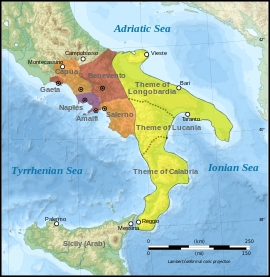Italy rune stones
Italy rune stones (English Italy runstones ) are called rune stones for Varangians who died in Katepanat Italy ( Longobardia ).
Over 130 rune stones are divided into seven groups analogous to the distinctive words used: England- (30), Greece- (30), Hakon-Jarl- (3), Ingvar- (26), Italy- (4), Baltic Sea- (Baltic States and Finland - 14 stones) and about 30 Varangian rune stones (relating to Russia, Belarus, the Ukraine and neighboring areas), which are also available in one copy each in Denmark and Norway. The rune stones were set up in the late 11th century and are found exclusively in Sweden .
Historical background
Varangians have been known to have served the Byzantine Empire as warriors since the 10th century, especially in the Varangian Guard , an elite unit.
The Byzantine Empire also included the Katepanat Italy in the 11th century . These were repeatedly attacked by neighboring Lombard towns and Norman mercenaries. The area was slowly being lost. On April 15, 1071, Bari , capital of Longobardia , was the last Byzantine base to be conquered by the Normans. The people mentioned on the runestones likely died in one of these attacks.
Rune stones
Runestones for men who died in "Langbarðaland", the Nordic name for Italy.
Uppland : U 133, U 141,
Södermanland : Sö Fv1954; 22 and Sö 65
Web links
- 2. Runriket - Täby Kyrka (Swedish) ( Memento from June 4, 2008 in the Internet Archive )
- All-Nordic database for rune stones ( rundata )
literature
- Sven Birger Fredrik Jansson: Uppländska, Småländska och Sörmländska Runstensfynd . In: Swedish National Heritage Board (ed.): Fornvännen . 49, 1954, ISSN 1404-9430 , pp. 1-25. on-line
- E. Wessén, Jansson, Sven BF: Sveriges Runinskrifter: VI. Upplands Runinskrifter del 1 . Kungl. Vitterhets Historie och Antikvitets Academies, Stockholm 1940–1943, ISSN 0562-8016.
See also
- Greece rune stones (rune stones for Varangians in the Byzantine Empire)


